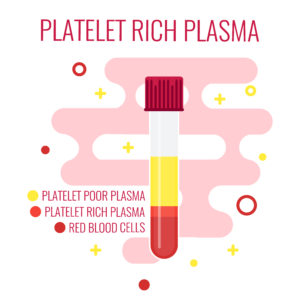Much has been made in recent years of Platelet Rich Plasma (PRP) injections as many professional athletes have tried this non-surgical treatment for the treatment of muscle, ligament, and tendon injuries. While many physicians claim that PRP is a wonder treatment, there are certain circumstances where patients should be wary about the effectiveness of PRP injections.
How Does PRP Work?
PRP is a natural treatment that uses only the patient’s own blood to stimulate a healing response in muscle, tendons and ligaments. Specifically, platelets, which are one of the components in the blood that are responsible for healing and repairing injuries, are injected directly into the injured area.
The process starts by drawing the patient’s own blood and then placing it into a centrifuge so that the platelets can be separated from the rest of the blood products. Once the platelets have been separated, they are injected into the injured area in the hope of stimulating a healing response in the injured tissue. These injections can be repeated over the course of several months, if needed.
Is PRP Effective for Arthritis?
One of the more commonly advertised applications for PRP injections is for those patients who are suffering from osteoarthritis of the knee. Many of those patients who are looking to avoid or delay Knee Replacement surgery have tried PRP injections with varying degrees of success. PRP has NOT been shown to regenerate cartilage. At best it may reduce the inflammation present in the knee from underlying arthritis. In many cases, these injections of PRP have only provided the level of pain relief seen after a corticosteroid (“cortisone”) type of injection. The relative success of PRP has been felt to be associated with the severity of the osteoarthritis that is present in the knee, as osteoarthritis has been classified in 4 stages.
Stage I: Minor
Minimal signs of osteoarthritis and small formations of osteophytes (bone spurs) are present in the knee. Some discomfort and stiffness may be felt in the knee but significant deterioration of cartilage has not yet occurred.
Stage 2: Mild
Larger osteophytes (bone spurs) are visible via X-Ray and the cartilage of the knee has begun to become thinner. Stiffness and an achy feeling, tend to become more prevalent.
Stage 3: Moderate
Significant loss of cartilage has occurred in the knee as well as the formation of larger visible osteophytes . The tissue and cartilage of the knee may become inflamed and patients feel consistent pain, especially after activity.
Stage 4: Severe
Little to no cartilage is left in the knee joint and X-Rays will show that the bones of the knee have begun to rub. Also, there is an associated significant loss in the quantity and quality (viscocity) of the naturally occurring lubricating fluid in the knee resulting in a greater level of stiffness and pain.
For PRP injections to be effective, there must be a sufficient enough amount of cartilage present in the knee joint so that the injection can be applied to that cartilage and thus reduce the inflammation present in the knee. As the cartilage continues to deteriorate, PRP injections become far less effective.
A recent study showed that 73% of patients (ages 30-70) with Stage 1 and Stage 2 osteoarthritis of the knee had reduced pain levels, increased functionality of the knee, and no progression of these early stages of arthritis at one year after receiving the PRP injections. However, for those with Stage 3 and Stage 4 osteoarthritis, clinical results have not shown the same level of efficacy.
Answer: PRP injections can be considered for those patients in the early phases of osteoarthritis of the knee. However, for those in the later stages, PRP will not be effective and is not a viable alternative to a surgical procedure.
Is PRP Effective for Sports Injuries?
The other most common application of PRP injections is for sports injuries, such as ligament injuries and tendonitis. The ligaments and tendons are long fibrous structures that help move the joints and are often common areas of injuries for athletes. Over time, small traumas to the joints and ligaments can cause small tears to form and with proper rest these tears tend to heal on their own. However, when multiple tears begin to occur, or a tear grows larger, this is when patients begin to experience the symptoms of pain, commonly associated with tendonitis or a ligament injury.
Utilizing PRP injections to “super-charge” or accelerate the healing of these injuries may be tempting, as many athletes including Tiger Woods and Kobe Bryant have traveled as far as Germany for these injections. However, the effectiveness of PRP for sports injuries is based on both the size of the tear and the presence of scar tissue in the tendon or ligament. If the area has bee injured many times, scar tissue can begin to replace the healthy tissue and blood will no longer flow through scar tissue. Therefore, applying blood platelets to scar tissue will have no effect.
Answer: For small tears or traumas to ligament or tendon, PRP can be considered. However, if large tears are present, or significant scar tissue has formed or the structure has been detached from its original position (ACL Tear, Torn Rotator Cuff, etc), PRP will not be effective.
Dr. Nicholas Alexander is the Founder of Mahwah Valley Orthopedic Associates and a Board Certified Orthopedic Surgeon specializing in both the surgical and non-surgical treatment of hip and knee conditions as well as sports injuries. Dr. Alexander completed his Fellowship in Adult Reconstruction and Reconstructive Surgery of the Hip and Knee at the Johns Hopkins School of Medicine and has over two decades of experience. He also serves as the Chairman of the Valley Hospital Total Joint Center. Dr. Alexander has offices in Mahwah and Clifton, NJ. If you, or someone you love, is considering treatment for an orthopedic or sports injury, contact us today for a consultation.



